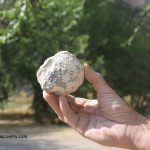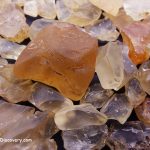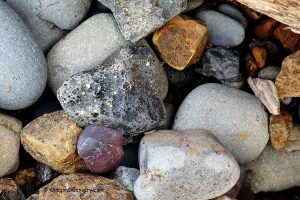
Oregon, with its geographic and geologic diversity, is a unique state, offering a great gem-hunting experience. The land of the waves-washed coastline, high deserts, river valleys, towering volcanoes and mountain ranges are rich in mineral deposits.
Along the 300 miles of the Pacific Coast, there are a great number of excellent locations to find agate, jasper, petrified wood, and marine fossils. The Willamette River and its tributaries carry mineral materials from volcanic deposits of the Cascade Mountains.
The high desert and forest of Central Oregon provide great opportunities to find high-quality thundereggs, geodes, agate, jasper, petrified wood, limb casts, and obsidian. Eastern and Southeastern Oregon are known to be the regions with the great source of agate, jasper, thundereggs, geodes, petrified wood, and leaf fossils.
Oregon Rockhounding Map - Free & Fee Sites
Oregon Rocks & Minerals
Oregon is one of the most popular states for agate hunting, offering numerous public lands where collectors can expand their gemstone collections. Before accessing any area, it’s important to contact local agencies for the most up-to-date information and regulations.

![]()
Crystalline Quartz, Agate, Jasper, and Chert
Across the state, you can find crystalline quartz, agate, jasper, and chert in many forms and colors. These minerals often occur in volcanic and metamorphic zones, weathering out of ancient lava flows and surfacing along coastlines, riverbeds, and desert outcrops.
Chert is typically found in marine sedimentary layers along the Oregon Coast, the Columbia River, and throughout Eastern Oregon.

![]()
Thundereggs
Oregon produces an impressive variety of thundereggs, known for their wide range of colors and patterns. Central and Eastern Oregon are among the most famous regions in the world for thunderegg hunting. The most productive areas include the Ochoco National Forest, the high desert near Prineville and Madras, and Succor Creek Canyon in Eastern Oregon.
Thunderegg is the official rock of Oregon.

![]()
Obsidian
Oregon is famous for its high-quality obsidian, especially in the volcanic regions of Central and Southern Oregon. The best-known collecting areas include Glass Butte near Burns, where rockhounds can find a variety of obsidian types such as rainbow, mahogany, and midnight lace. Another great location is Mud Ridge at Hines.

![]()
Petrified Wood and Limb Cast
The state offers many excellent locations to find petrified wood and limb casts, especially in the central and eastern parts of the state. The Hampton Butte area is one of the best-known sites, famous for its colorful green petrified wood. Bear Creek, Congleton Hollow, and Dendrite Butte also yield beautiful specimens. In Eastern Oregon, Negro Rock, Succor Creek, Fremont National Forest, and areas around McDermitt are known for well-preserved limb casts and petrified wood.

![]()
Oregon Sunstone
Oregon Sunstones are found exclusively in the high desert of southeastern Oregon. Known for their warm colors ranging from pale yellow to deep red and green, sunstones often display a shimmering effect called aventurescence. The most popular collecting areas include the Bureau of Land Management’s Oregon Sunstone Public Collection Area near Plush and several mines including Dust Devil’s, Spectrum Sunstone, and Double Eagle that allow visitors to search for their own sparkling treasures.
Oregon Sunstone is designated as the official state gemstone.

![]()
Oregon Fossils
Fossil hunting in Oregon offers a remarkable variety—from marine shells and invertebrates along the coast to leaf impressions and ancient plants in the high desert. Marine fossils aren’t limited to the coast; Oregon’s geologic history reveals that ancient seas once covered much of the state. As a result, marine fossils such as shells, corals, and other invertebrates can be found far inland, preserved in sedimentary layers that formed millions of years ago.
Common public fossil collecting areas include the Oregon Coast, Wheeler High School Fossil Beds, Delintment Lake, and Beulah Lake.
Recreational Rockhounding Guide - Shortly
The majority of rock and mineral collecting sites are lying on the federal lands managed by BLM (Bureau of Land Management) or U.S. Forest Service.
The U.S. Forest Service limits amounts of specimens up to 10 pounds. Some lands within the National Forest are closed for collecting due to wilderness designation.
The BLM (Oregon & Washington) no-fee daily collecting limits of rocks and minerals including semiprecious gemstones, mineral specimens, and common invertebrate fossils in reasonable amounts for personal use. Petrified wood can be collected for personal use — up to 25 pounds each day, plus one piece, but no more than 250 pounds in any calendar year.
Collection does not occur in developed recreation sites or areas, unless designated as a rockhounding area by BLM.
The collection of agates on the beaches is limited to one gallon per day and three gallons per year.
Rockhounding is restricted in Wilderness Area to the surface collection only.
Items May Not Be Collected
- Vertebrate fossils (dinosaurs bones, fish, - anything with a backbone), and shark teeth
- Any material remains of prehistoric or historic human life or activities
- Projectile points include ‘arrowheads’ and pottery
Caution: Abandoned mine sites are unstable and extremely dangerous. Rotten timber, open shafts, poisonous gases, insufficient oxygen can be lethal. Never attempt to enter and explore abandoned mines.
Read More: Rules of Recreational Rock, Mineral and Fossil Collecting
DISCLAIMER
The Oregon Rockhounding Map provides information about some of the many rockhounding sites of the state of Oregon. Information is subject to change at any time, and Oregon Discovery team cannot guarantee that is either current or correct. Be aware that there are some mine claims and private lands near the public collecting areas. Determining the land status and minerals' collection rules at the site is your primary responsibility.
Currently, this map is incomplete but new rockhounding sites and related details will be added in the future.
You May Also Like








